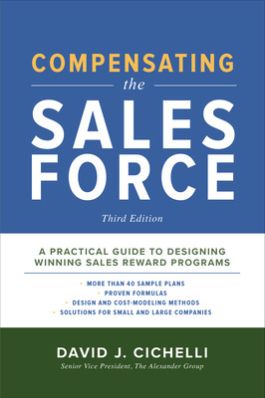Compensating the Sales Force, Third Edition: A Practical Guide to Designing Winning Sales Reward Programs
Acknowledgments
Preface
Introduction
1. Why Sales Compensation?
The Role of the Sales Force
Why Sales Compensation Works
The Power of Sales Compensation
Job Content—The Source of Sales Compensation Design
Sales Jobs and Sales Process
Sales Compensation—Paying for the Point of Persuasion
Sales Force Obsolescence and Sales Compensation
The Impact of Customer Relationship Management
What Can Go Wrong?
Summary
2. Sales Compensation Fundamentals
Variable Compensation Models
Income Producers versus Sales Representatives
About Sales Compensation Concepts
Sales Compensation Design Elements for Sales Representatives
Eligibility
Target Total Cash Compensation
Pay Mix and Leverage
Performance Measures and Weights
Quota Distribution
Performance Range
Performance and Payment Periods
Summary
3. Who Own Sales Compensation?
Sales Compensation Program Ownership
Program Accountabilities
Assignment of Program Accountabilities—Large Sales Organizations
Using Committees
Sales Compensation—The Process Manager
Summary
4. Why Job Content Drives Sales Compensation Design
Job Content Drives Sales Compensation Design
Sales Job Components
Sales Job Type Inventory
Job Levels
Job Design Errors
Sales Compensation Practices by Job Types
Summary
5. Formula Types
Types of Plans
Illustrating Formula Payouts with Sales Compensation Formula Graphs
Unit Rate Plans
Target Pay Incentive Plans: Commission versus Bonus
Target Incentive Plans: Commission Formula
About Link Designs
Bonus Formula: Providing Equal Earning Opportunities When Territories
Are Dissimilar in Size
Target Bonus Plans
Bonus—Calculation Basis
Special Designs
Add-On Plans
Base Salaries
Summary
6. Formula Construction
Fundamentals of Sales Compensation Formulas
The Economics of Income Producers
Advanced Thinking about Income Producer Commission Rates
Constructing Sales Representative Formula
Formula Construction Worksheets
Summary
7. Plan Cost Modeling
Modeling Objectives
Successful Plan Modeling Steps
Summary
8. Support Programs: Territories, Quotas, and Crediting
Territory Configuration
Quota Management
Sales Crediting
Summary
9. Employment Status and Pay Implications
New Hires
Lateral Transfers
Promotions
Involuntary Terminations
Resignations
Leave of Absence
Vacation Treatment
Temporarily Assigned Accounts
Summary
10. Difficult-to-Compensate Sales Jobs
Channel Sales Representative
Long Sales Cycle Mega-Order Seller
Business Development Specification Seller
Strategic Account Manager
Pursuit Team
New Account Seller
Account Manager
Overlay Specialist
New Hire
Branch Manager
House Account Manager
Sell and Deliver Service Providers
Merchandiser
Summary
11. Small Companies, Big Companies—Sales Compensation Solutions
Does Company Size Affect Sales Compensation?
Small Business, Small Sales Force
Fast-Growing Start-Up Companies
Cottage-Style Growth Companies
Large Companies
Summary
12. Compensating the Complex Sales Organization
Examples of Complex Sales Organizations
Challenges for Sales Compensation
Preferred Sales Compensation Outcomes
Sales Compensation Rules for Complex Sales Entities
Summary
13. Global Sales Compensation
The Philosophy of Internationalism versus Globalism
Sales Compensation—A Local Solution
Global Trigger Conditions
Global Sales Compensation Solutions
Trends in Global Sales Compensation Practices
Summary
14. Administration
Administration Components
How to Avoid Unnecessary Administrative Burdens
Summary
15. Implementation and Communication
Implementation
Communication
Summary
16. Program Assessment
Strategic Alignment
Employee Motivation
Best- Practice Variance
Return on Investment
Program Management
Summary
17. Sales Compensation Design
The Sales Compensation Design Process
10 Steps to Sales Compensation Design
Summary
Closing Notes
Appendix A: Sales Compensation Design Principles
Appendix B: Sample Sales Compensation Plan
Appendix C: Sales Compensation Survey Companies
Appendix D: Sales Compensation Administration Software Vendors
Index
Leverage the full power of your sales force with a cutting-edge compensation program
Salespeople are motivated by many things—and how they’re paid tops the list. Sales compensation is one of the best tools for motivating any sales force and thus maximizing business revenue. Do you have strategically aligned sales compensation plans or are your pay plans holding back your sales force?
Compensating the Sales Force has helped thousands of business leaders worldwide create sales compensation programs that drive sales performance, increase revenue, and trigger business growth. Now, this new edition brings you fully up to date with new approaches for a business landscape where product/solution objectives and customer needs are in constant in flux.
Sales guru David Cichelli provides everything you need to build an incentive plan that delivers real financial results. He takes you step-by-step through the process of setting target pay, selecting the right performance measures, and establishing quotas. You’ll learn everything there is to know about:
• Why job content drives sales compensation design
• Methods for calculating formulas for payout purposes
• The roles of quota allocation, sales crediting, and account assignment
• Compensating a complex sales organization and global sales teams
• Administering, monitoring, and measuring the effectiveness of the program
An indispensable resource for anyone involved in sales compensation—from CEOs and sales managers to HR personnel to IT professionals—Compensating the Sales Force provides all the tools you need to design and implement a sales compensation plan that increases profits?and drives the sales team to exceed sales targets.

